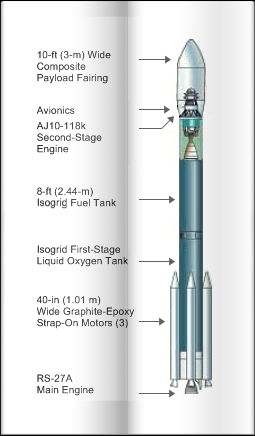
| The Miscellaneous Types of Rockets | The Structure Of a Rocket |
Launchers are rockets as they are used to launch into orbit, and/or unto a planetary trajectory, the miscellaneous space, manned or unmanned missions. Rockets are composed of an engine providing thrust, of a propellant, and control systems. The cargo -or payload- comes atop the vehicle. A rocket carries fuel and an oxidizer, in order the fuel to burn in the vacuum of space. Most present launch vehicles consist ot two or more stages, each one with its engines and propellant. Each stage is fired following the other. Once a stage is out of burn, it's jettisoned. Liquid or solid propellants are the chemical propellants in use today in rocketry. The liquid sort burns together two liquid chemicals stored separately. It sorts further into liquid-cryogenic (the RP-1 Kerosene with liquefied oxygen as an oxidizer), cryogenic (both chemicals are cold, liquefied gases like liquid hydrogen and oxygen and need a flame or spark when put together in the combustion chamber), and hypergolic ones (both chemicals just ignite by themselves when put into contact to each other, like aniline and nitric acid). Solid propellants have the fuel and oxidizer mixed uniformly together under a solid form (this form is more stable and can be more easily manufactured and stored). Liquid hydrogen and liquid oxygen are cooled to -423 degrees Fahrenheit (-252.8°C.) and -297 degrees Fahrenheit (-182.8°C.) respectively. Insulation protects the launcher's tanks from ice build-up resulting from such subzero temperatures. Liquid propellant rockets may be throttled, turned off, and restarted through pumps as solid propellant rockets can't as they don't have any pumps. Once ignited, their propellant burns until the end. Since a while, large solid rocket motors have become a primary propulsion element in modern rocketry, as used as boosters for the space shuttle, Atlas V and Delta IV rockets and several military applications. They provide high thrust, or lifting power, for relatively low cost, and do not have the more costly refrigeration and insulation requirements of cryogenic liquid-fueled rockets. In the late 1950's and early 60's NASA Glenn center worked about rocket's propellants. It originally started to develop hydrogen fuel for aircraft as that soon evolved into hydrogen fuel for rocket engines which had never been done before and also cryogenic liquid hydrogen fuels, most energetic rocket propellants that one can have. Such pioneering work set the stage for liquid hydrogen to become the propellant for NASA’s large expendable launch vehicles program, in particular, the RL-10 rocket engine and the Centaur high-energy upper stage. The Centaur upper stage then became NASA’s workhorse over the next 40 years, launching 80 satellites and missions
Ion propulsion, as far as it is concerned, differs from chemical propulsion. As chemical propulsion produces large amounts of thrust for a short period of time, ion propulsion produces a small amount of thrust for long periods of time. The result of a continually burning ion propulsion element is a spacecraft traveling at significantly higher speeds than is possible with chemical propulsion. It was, between 1959 and 1960, Dr. Harold R. Kaufman of NASA’s Glenn Research Center in Cleveland, Ohio, who developed and tested the first electron bombardment thruster. The technology can be used for not only primary propulsion but also as secondary propulsion to ensure the spacecraft maintains the proper orientation or attitude. Around 1970, development of industrial uses for ion beam technology began like microcircuit etching and deposition of thin films for many products, including optical equipment
Starting by the end of WW2, each main actor of the space conquest developed its lines of rockets based on ballistic missiles. Launchers always mostly were -and still are- Expendable Launch Vehicles (ELVs), that is they are not reusable. Stages are jettisoned once used. Hydrazine, as far as it is concerned, is nowadays the main carburant for missions' thrusters. First used in rocket engines by the German Luftwaffe during WW2, the hydrazine is a ‘hypergolic’ carburant which means it ignites spontaneously on contact with a oxidiser or by itself with a catalyst. Hydrazine is also highly corrosive and extremely toxic. Hydrazine nowadays is mostly used to power a spacecraft's thruster
Current rocket science, albeit about one hundred years old, is now allowing us to speeds which render the exploration of the solar system allowable. 9 years are still needed however to reach Pluto. Current tech would still need about 50,000 years to journey to through 4.2 light years! In terms of a journey to Mars, ion propulsion could allow to a length reduced by several months
A diagram of the various systems of a Boeing Delta II launcher is providing a first opportunity to describe what the components of a launcher are
 | a Boeing Delta II. picture The Boeing Company |